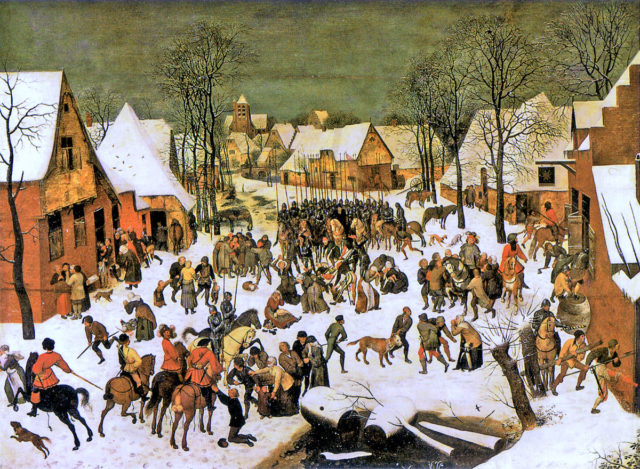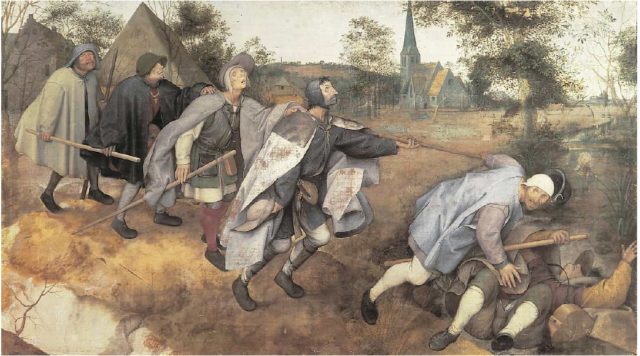One of the leading painters of the Flemish Renaissance, Pieter Bruegel from Brabant, had the luck (or misfortune) of living during a time when the Italian influence on art was at its peak.His frequent trips to Italy for the sole purpose of studying inspired him to channel his distinctive artistic expression.
Still, while he was influenced by Italy’s majestic opus of great art, he kept to the style of Hieronymus Bosch as a foundation for his own work.
Bruegel is known for intricate landscapes and scenes of common folk and peasants. This style is also known as “genre painting,” and he was a pioneering figure in drawing focus to both types of subjects simultaneously. The “hustle and bustle” of common life and the enormous landscape element show how the works of Bosch influenced the artist, although Bosch gave greater emphasis to concepts and narratives of a religious nature than Bruegel.
Bruegel was a true influence on the Golden Age of Dutch painting. This is because his choice of subjects made him one of the very first, in a generation of artists, to produce innovative work during the time when religion, as a subject, was losing popularity because of the Protestant Reformation.
In 1551, around the age of 26, he was regarded as a master painter in the Antwerp painter’s guild. After his education in Italy, he returned to Antwerp in 1555, where he designed and printed paintings. His travels through the Alps gave him the inspiration to paint beautiful mountain landscapes.

It was only toward the end of the decade that he decided to focus fully on painting as his main medium. Most of his greatest paintings are from the period of around 15 years prior to his death, when he was at the height of his abilities.
Bruegel’s nickname, “Peasant Bruegel,” comes from the fact that he frequently wore peasant’s clothes, despite having a pretty high status as a painter in Antwerp. He would don peasant’s attire to mingle among the common folk, attending their many social gatherings and weddings.

By interacting with the peasants he gained insight into the everyday happenings in their lives, giving his paintings true representation of the simple life as he saw it. This nickname was equally used to distinguish him from his sons, Pieter Brueghel the Younger and Jan Brueghel the Elder, who also became prominent painters in their own right.

Unparalleled in his ability to depict busy Flemish crowds mixed with natural landscapes, he also succeeded in leaving undeniable social commentary through his works.
The Flemish authorities were reluctant but nevertheless gave him permission to exhibit his paintings. Allegedly, while on his deathbed, Bruegel’s wish was that his most “controversial” paintings be burned, fearing that his family could be persecuted by the strict authorities otherwise.
Bruegel, unlike his contemporaries, managed to reflect a flawless synthesis of Bosch’s religious symbolism and combine it with his own perspective on the human condition.
There is a strong belief among art critics that Bruegel was trying to replace the standardized, religious theme of Flemish art with his very own, unique eschatology.
The Flemish Proverbs is a fine example of Bruegel’s approach to literary allegory through painting. It is an oil-on-oak-panel painting depicting literal illustrations of Dutch proverbs. Running themes in Bruegel’s paintings include the absurdity, wickedness, and foolishness of humans, and this one is no exception.
One of his other paintings in which he channels his socio-political views is Massacre of the Innocents. Critics argue over whether or not this painting was a sharp-tongued criticism against the atrocities of the Spanish Inquisition in the Netherlands.
The Peasant Dance (c. 1566-1567) shows Bruegel’s important newfound artistic direction, which emerged in the last years of his life. Bruegel switched to painting in a “large figure” style where the peasants are illustrated as lively and animated, conveying the rhythms and patterns of dancing.
With this, he also reduced the forms to their elemental essence and managed to enhance and hone the detail of the design and color of his paintings.

The Wedding Dance, one of his most famous and beloved works, was painted to honor the simplicity and honesty of the country folk. The painting definitely shows Bruegel’s wit. The droll and comical depiction also captures the artist’s genius for magnifying the details of the most common pastimes of human activity.
The painting was lost for many years until its discovery at a sale in London in 1930 by William R. Valentiner, the director at the time of the Detroit Institute of Arts.
In one of his more famous works, The Parable of the Blind, the artist refers to Matthew (14:14), “If the blind lead the blind, both shall fall into the ditch.” The descending diagonal line in which the figures move from left to right is vivid and emphasized the intricate use of color and hues. It may be related to the establishment of the Council of Troubles in 1567 by the government of the Spanish Netherlands, but it is not clear whether the painting was meant as a political statement.

Bruegel was living in Brussels in 1563, and he remained there until his death in 1569. He was one of the most tireless artists of the 16th century and is regarded as a brilliant artist and illustrator of the daily life of the Flemish peasants. Today, his intricately detailed, enormous landscapes continue to be seen as the highest level of Flemish art.

Even though Bruegel’s best-remembered style is of country folk life, his paintings also give a poignant and true insight into the dichotomy of man’s relationship to nature. Bruegel’s paintings summarize the old ways of that time, standing on the precipice of a new era that was channeled through the Renaissance.
Read another story from us: E.T. Compton – The mountain painter who made at least 27 first ascents
In that era’s fast-paced chaos, whether cultural, religious, social, or political in nature, Bruegel’s art remains celebrated among the greats of the Flemish Renaissance. His artistic reputation as one of the greatest Dutch Renaissance painters is truly certified.
